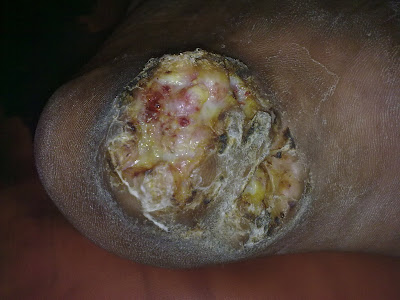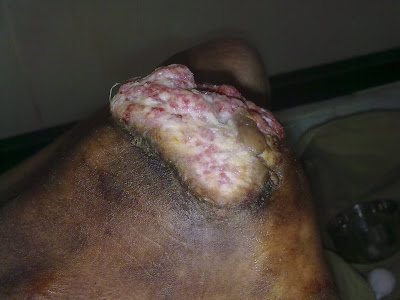
Hi I am Dr. Suchet Chaudhary a postgraduate student of surgery under the guidance of DR. SANTHOSH JOHN ABRAHAM an eminent surgeon and a teacher at Lourdes Hospital, Cochin, Kerala(India). This blog is an attempt to have a visual clinical tool to identify various health conditions we come across in day-to-day clinics. The material (pictures, clinical/radiological data etc) is collected mainly during our daily ward rounds and from OPD/OT cases. Suggestions/comments are welcome !
Tuesday, December 22, 2009
Monday, December 21, 2009
Gynaecomastia
 Gynecomastia, is the development of abnormally large mammary glands in males resulting in breast enlargement. The term comes from the Greek (γυνή) gyne (stem gynaik-) meaning "woman" and (μαστός) mastos meaning "breast".
Gynecomastia, is the development of abnormally large mammary glands in males resulting in breast enlargement. The term comes from the Greek (γυνή) gyne (stem gynaik-) meaning "woman" and (μαστός) mastos meaning "breast".
- This condition can occur physiologically in neonates due to female hormone from mother and the discharge is known as 'Witches milk'.
- Breast prominence due solely to excessive adipose is often termed as pseudogynaecomastia or sometimes lipomastia.
- The condition should be differentiated from work hypertrophy of the pectoralis muscles caused by exercise.
- Types are:
- Puffy nipples: very common, glandular tissue is concentrated under and typically confined to areola.
- Pure glandular: In bodybuilders this may be a result of the use of anabolic steroids
- Adolescent: Congenital/Hereditary- boys of 9-14 years.
- Adult: most common.
- Pseudogynaecomastia: This is generally the only type which can be improved by liposuction.
- Asymmetrical/Unilateral.
- Severe: is characterized by excess and/or saggy skin and severely enlarged breasts.
Treatment:
- Correcting underlying cause.
- Selective estrogen receptor modulator eg. tamoxifen, clomiphen or androgens or aromatase inhibitor such as letrozole.
- Surgery: Reduction mammoplasty, liposuction, gland excision
- Radiation therapy is sometimes used to prevent gynaecomastia in patients with prostrate cancer prior to estrogen therapy.
Labels:
atlas of surgery,
breast,
gynaecomastia,
male breast
Monday, December 14, 2009
Trichobezoar
Hair balls.
Salient features:
Unusual
Virtually exclusively found in young female phychiatric patients
Caused by pathological ingestion of hair.
Presentation is often suggestive of Ulceration, GI bleeding, perforation or Obstruction.
Endoscopy is diagnostic, Plain x-rays may help.
Treatment is removal: endoscopically or sometimes open surgery.
Other similar condition is Phytobezoars which are made of vegetable material and found principally in patients with gastric stasis.
Sunday, December 13, 2009
Local Gigantism
Local gigantism is a condition in which a certain part of the body acquires larger than normal size due to excessive growth of the anatomical structures or abnormal accumulation of substances. It is more common in fingers and toes, where it is termed macroodactyly.
This is broadly classified into two:
CONGENITAL:

 ACQUIRED:
ACQUIRED:
4. Elephantiasis (S-E Asia, filariasis)
5. Still's disease
6. Amyloidosis
7. Acromegaly
Treatment ranges from antibiotics to correction of the underlying anatomic anomaly.
This is broadly classified into two:
CONGENITAL:
- Klippel Trenaunay Weber syndrome
- Maffucci syndrome
- Macrodystrophia lipomatosa
- Nerurofibromatosis
- Lipoatrophic diabetes
Proteus syndrome, which affected the elephant man:

 ACQUIRED:
ACQUIRED:- Inflammation
- Tumors - osteoid osteoma, melorheostosis, lipofibromatous hamartoma
4. Elephantiasis (S-E Asia, filariasis)
5. Still's disease
6. Amyloidosis
7. Acromegaly
Treatment ranges from antibiotics to correction of the underlying anatomic anomaly.
Labels:
atlas of surgery,
giant,
gigantism,
Local gigantism,
suchet,
suchet chaudhary
Monday, December 7, 2009
Subscribe to:
Posts (Atom)













